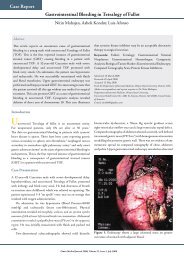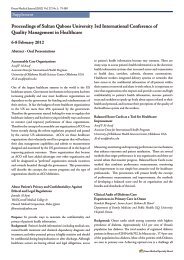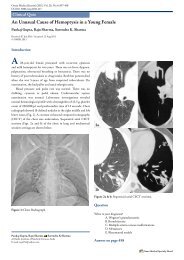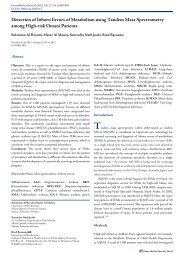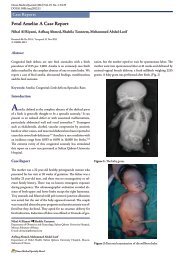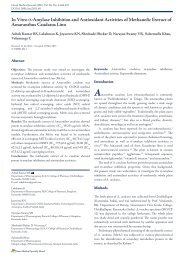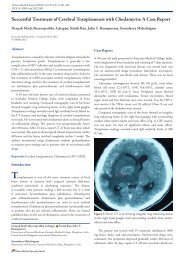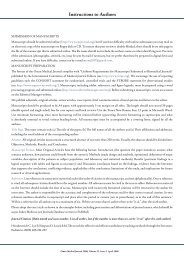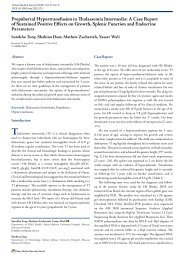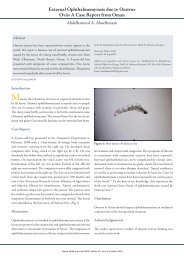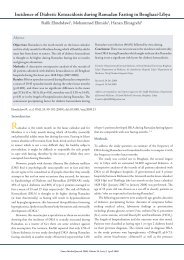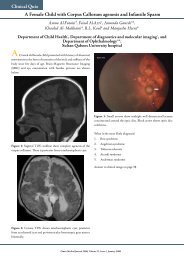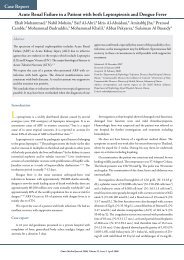Recurrent Laryngeal Nerve Injury in Thyroid Surgery
Recurrent Laryngeal Nerve Injury in Thyroid Surgery
Recurrent Laryngeal Nerve Injury in Thyroid Surgery
Create successful ePaper yourself
Turn your PDF publications into a flip-book with our unique Google optimized e-Paper software.
Oman Medical Journal (2011) Vol. 26, No. 1: 34-38<br />
DOI 10. 5001/omj.2011.09<br />
<strong>Recurrent</strong> <strong>Laryngeal</strong> <strong>Nerve</strong> <strong>Injury</strong> <strong>in</strong> <strong>Thyroid</strong> <strong>Surgery</strong><br />
Hazem M. Zakaria, 1 Naif A. Al Awad, 1 Ali S. Al Kreedes, 1 Abdul Mohs<strong>in</strong> A. Al-Mulhim, 1<br />
Mohammed A. Al-Sharway 1 , Maha Abdul Hadi, 1 Ahmed A. Al Sayyah 2<br />
Received: 31 May 2010 / Accepted: 26 Jul 2010<br />
© OMSB, 2011<br />
Abstract<br />
Objectives: Vocal cord paresis or paralysis due to iatrogenic<br />
<strong>in</strong>jury of the recurrent laryngeal nerve (RLNI) is one of the ma<strong>in</strong><br />
problems <strong>in</strong> thyroid surgery. Although many procedures have<br />
been <strong>in</strong>troduced to prevent the nerve <strong>in</strong>jury, still the <strong>in</strong>cidence of<br />
recurrent laryngeal nerve palsy varies between 1.5-14%. The aim of<br />
the present study is to assess the risk factors of recurrent laryngeal<br />
nerve <strong>in</strong>jury dur<strong>in</strong>g thyroid surgery.<br />
Methods: Patients who had thyroid surgery between 1990 and<br />
2005 and were admitted to the surgical department of K<strong>in</strong>g Fahd<br />
hospital of the University, Al-Khobar, Saudi Arabia were enrolled<br />
for this retrospective review, Factors predispos<strong>in</strong>g to recurrent<br />
laryngeal nerve <strong>in</strong>jury were evaluated such as pathology of the<br />
lesions and the type of operations and identification of recurrent<br />
laryngeal nerve <strong>in</strong>tra-operatively. Preoperative and postoperative<br />
<strong>in</strong>direct laryngoscopic exam<strong>in</strong>ations were performed for all<br />
patients.<br />
Results: 340 patients were <strong>in</strong>cluded <strong>in</strong> this study. Transient<br />
unilateral vocal cord problems occurred <strong>in</strong> 11 (3.2%) cases, and <strong>in</strong> 1<br />
(0.3%) case, it became permanent (post Rt. Hemithyroidectomy).<br />
Bilateral vocal cord problems occurred <strong>in</strong> 2 cases (0.58%), but<br />
none became permanent. There were significant <strong>in</strong>creases <strong>in</strong><br />
the <strong>in</strong>cidence of recurrent laryngeal nerve <strong>in</strong>jury <strong>in</strong> secondary<br />
operation (21.7% <strong>in</strong> secondary vs. 2.8% <strong>in</strong> primary, p=0.001),<br />
total/near total thyroidectomy (7.2% <strong>in</strong> total vs. 1.9% <strong>in</strong> subtotal,<br />
p=0.024), non-identification of RLN dur<strong>in</strong>g surgery (7.6% <strong>in</strong> nonidentification<br />
vs. 2.6% <strong>in</strong> identification, p=0.039) and <strong>in</strong> malignant<br />
disease (12.8% <strong>in</strong> malignant vs. 2.9% <strong>in</strong> benign, p=0.004).<br />
However, there was no significant difference <strong>in</strong> the <strong>in</strong>cidence of<br />
recurrent laryngeal nerve <strong>in</strong>jury with regards to gender (4.1% <strong>in</strong><br />
male vs 3.8% <strong>in</strong> female, p=0.849).<br />
Conclusion: The present study showed that thyroid carc<strong>in</strong>oma, reoperation<br />
for recurrent goiter, non-identification of RLN and total<br />
thyroidectomy were associated with a significantly <strong>in</strong>creased risk<br />
of operative recurrent laryngeal nerve <strong>in</strong>jury.<br />
Hazem M. Zakaria , Naif A. Al Awad, Ali S. Al Kreedes, Abdul<br />
Mohs<strong>in</strong> A. Al-Mulhim, Mohammed A. Al-Sharway, Maha Abdul Hadi<br />
Department of <strong>Surgery</strong>, College Of Medic<strong>in</strong>e, Dammam University, Dammam,<br />
K<strong>in</strong>gdom of Saudi Arabia.<br />
E-mail: hazakaria@yahoo.com<br />
Ahmed A. Al Sayyah<br />
Department of Pathology, College Of Medic<strong>in</strong>e, Dammam University,<br />
Dammam, K<strong>in</strong>gdom of Saudi Arabia.<br />
Keywords: <strong>Thyroid</strong>ectomy, recurrent laryngeal nerve <strong>in</strong>jury,<br />
carc<strong>in</strong>oma of thyroid<br />
Introduction<br />
<strong>Thyroid</strong> surgery is a common surgical procedure <strong>in</strong> the<br />
K<strong>in</strong>gdom of Saudi Arabia. 1,2 Complications such as bleed<strong>in</strong>g,<br />
hypoparathyroidism and <strong>Recurrent</strong> <strong>Laryngeal</strong> <strong>Nerve</strong> <strong>Injury</strong><br />
(RLNI) represent nearly half of all the complications of thyroid<br />
surgery. 3-5 The latter complication after thyroidectomy, although<br />
<strong>in</strong>frequently encountered, can jeopardize the quality of life. 6<br />
In addition to the hoarseness that occurs with unilateral<br />
RLNI, bilateral RLNI leads to dyspnea and often life-threaten<strong>in</strong>g<br />
glottal obstruction. 7,8 The <strong>in</strong>cidence of RLNI has been found to<br />
be higher dur<strong>in</strong>g re-explorations, Graves disease and thyroid<br />
carc<strong>in</strong>oma procedures. 9,10<br />
RLNI is a major concern <strong>in</strong> thyroid and parathyroid surgery.<br />
Therefore, methods that can reduce the <strong>in</strong>cidence of this<br />
complication are of great <strong>in</strong>terest. 11 An almost certa<strong>in</strong> way to ensure<br />
the <strong>in</strong>tegrity of the RLN is to always identify the nerve dur<strong>in</strong>g all<br />
surgical procedure on thyroid and parathyroid glands. 12,13 The aim<br />
of the present study is to assess the factors <strong>in</strong>fluenc<strong>in</strong>g the risk of<br />
RLN <strong>in</strong>jury dur<strong>in</strong>g thyroid surgery.<br />
Methods<br />
A retrospective review was undertaken on all patients who had<br />
thyroid surgery between 1990 and 2005 and were admitted to<br />
the surgical department, K<strong>in</strong>g Fahd hospital of the University,<br />
Al-Khobar, Saudi Arabia. Patient’s charts were evaluated for<br />
history, physical exam<strong>in</strong>ation, thyroid function tests and operative<br />
reports for the type of operation (total, near total or subtotal<br />
thyroidectomy) andalso to check if RLN was identified or not.<br />
Reports of pre-operative and 3 days post-operative <strong>in</strong>direct<br />
laryngoscopy were recorded. Categories of the operation as<br />
primary surgery (no prior thyroid surgery) or secondary (one or<br />
more thyroid operations before this <strong>in</strong>tervention) were <strong>in</strong>cluded <strong>in</strong><br />
the study. Attempts were made to identify the RLN <strong>in</strong> all cases. In<br />
case of failure to identify the RLN, careful dissection of the gland<br />
and ligation of the related vessels close to their distal branches was<br />
carried out to avoid <strong>in</strong>jury. The cases were analyzed for RLNI <strong>in</strong><br />
relation to gender, category and type of surgical operation, as well<br />
Oman Medical Specialty Board
Oman Medical Journal (2011) Vol. 26, No. 1: 34-38<br />
as histopathological diagnosis. Dysphonia or vocal cord paralysis<br />
detected on <strong>in</strong>direct laryngoscopy was considered as transient<br />
paralysis if recovered with<strong>in</strong> 6 months and as permanent paralysis<br />
if it cont<strong>in</strong>ued beyond 6 months.<br />
Differences between the 2 groups (RLNI and no <strong>in</strong>jury) were<br />
tested for statistical significance us<strong>in</strong>g the chi-square test, Fisher’s<br />
exact test as appropriate. Significance was set at p
Oman Medical Journal (2011) Vol. 26, No. 1: 34-38<br />
Discussion<br />
In the last 25 years, total thyroidectomy has replaced bilateral<br />
subtotal thyroidectomy as the preferred option for the management<br />
of all patients with bilateral benign mult<strong>in</strong>odular goitre, Graves’<br />
disease, and all but very low-risk thyroid cancer patients. The<br />
pr<strong>in</strong>cipal change <strong>in</strong> operative technique has been the move from<br />
‘lateral dissection’ to ‘capsular dissection.’ 14<br />
The <strong>in</strong>cidence of Injuries to the recurrent laryngeal nerve has<br />
been reported between 1% to 2% from different thyroid surgery<br />
centres when performed by experienced neck surgeons. This<br />
<strong>in</strong>cidence is higher when thyroidectomy is performed by a less<br />
experienced surgeon, 15-17 or when thyroidectomy is done for a<br />
malignant disease. Sometimes the nerve is purposely sacrificed if<br />
it runs <strong>in</strong>to an aggressive thyroid Cancer. 18 In the present study,<br />
the rate of RLNI was 4.1%.<br />
This complication is generally unilateral and transient, but<br />
occasionally it can be bilateral and permanent and it may be either<br />
deliberate or accidental. 19,20 The permanent lesion of damaged<br />
RLN often manifests as an irreversible dysfunction of phonation<br />
and is the most common complication follow<strong>in</strong>g thyroid surgery. 21<br />
Permanent <strong>in</strong>juries to the recurrent laryngeal nerve are best avoided<br />
by identify<strong>in</strong>g and carefully trac<strong>in</strong>g the path of the recurrent<br />
nerve. 22 Surgeon’s experience, histopathologic diagnosis, previous<br />
thyroid surgery, surgical technique and anatomic variations are<br />
important factors affect<strong>in</strong>g this complication. 23<br />
Mechanisms of <strong>in</strong>jury to the nerve <strong>in</strong>clude complete or partial<br />
transection, traction, or handl<strong>in</strong>g of the nerve, contusion, crush,<br />
burn, clamp<strong>in</strong>g, misplaced ligature, and compromised blood<br />
supply. 24,25 In unilateral RLN,I the voice becomes husky because<br />
the vocal cords do not approximate with one another. Dysphonia<br />
start<strong>in</strong>g on the 2nd – 5th post-operative days is commonly due<br />
to edema, whereas traction <strong>in</strong>jury of the nerve and damage of<br />
axons may result <strong>in</strong> dysphonia last<strong>in</strong>g up to 6 months. Dysphonia<br />
cont<strong>in</strong>u<strong>in</strong>g after 6 months is commonly permanent caused by<br />
cutt<strong>in</strong>g, ligat<strong>in</strong>g or cauterization of the nerve. 26 Bilateral RLNI<br />
is much more serious, because both vocal cords may assume a<br />
median or paramedian position and cause airway obstruction and<br />
tracheostomy may be required. Accidental transaction commonly<br />
occurs at the level of upper two tracheal r<strong>in</strong>gs, where the nerve<br />
closely approximates the thyroid lobe <strong>in</strong> the area of Berry’s<br />
ligament. 27,28<br />
Despite many excellent studies, recurrent nerve dissection has<br />
repeatedly been questioned because there was either no change or<br />
an <strong>in</strong>creased risk of vocal cord paralysis. Several of these studies<br />
concluded that recurrent nerve dissection is not mandatory <strong>in</strong><br />
subtotal resection but still advocate the procedure for the sake of<br />
practice, that it will be useful <strong>in</strong> complicated cases (e.g., thyroid<br />
cancer). 29-31 In our study, the <strong>in</strong>cidence of RLNI <strong>in</strong>creased to 7.6%<br />
<strong>in</strong> cases where the nerve was not identified. Dissection beg<strong>in</strong>n<strong>in</strong>g<br />
from the avascular cricothyroid space was reported as a safe<br />
method of RLN preservation. 31<br />
The improved outcome after complete dissection can be<br />
rationalized as follows; “total dissection of the recurrent nerve over<br />
its entire cervical course precludes an <strong>in</strong>correct alignment,” it also<br />
allows the surgeon to verify the anatomic <strong>in</strong>tegrity of the nerve and<br />
to identify extra-laryngeal ramifications. This situation is clearly<br />
superior to partial exposure of the nerve, a conclusion that is also<br />
supported by the poor outcome of the surgeons who only aim to<br />
identify<strong>in</strong>g the nerve. 32<br />
In recent years, many surgeons have sought to try to further<br />
reduce the low <strong>in</strong>cidence of RLNI by use of nerve monitor<strong>in</strong>g<br />
devices dur<strong>in</strong>g surgery. Although several devices have been utilized,<br />
all have <strong>in</strong> common some means of detect<strong>in</strong>g vocal cord movement<br />
when the recurrent laryngeal nerve is stimulated. 32 Many small<br />
series have been reported <strong>in</strong> the literature assess<strong>in</strong>g the potential<br />
benefits of monitor<strong>in</strong>g to decrease the <strong>in</strong>cidence of nerve <strong>in</strong>jury. 31,32<br />
Given the low <strong>in</strong>cidence of RLNI, it is not surpris<strong>in</strong>g that none<br />
of the studies have shown any statistically significant decrease <strong>in</strong><br />
RLNI by us<strong>in</strong>g a nerve monitor. The use of a nerve stimulator<br />
did not aid <strong>in</strong> anatomical dissection of the RLN and was useful<br />
<strong>in</strong> identify<strong>in</strong>g only superior laryngeal nerve. Discont<strong>in</strong>uous nerve<br />
monitor<strong>in</strong>g by stimulation dur<strong>in</strong>g total thyroidectomy confers no<br />
obvious benefit for the experienced surgeon <strong>in</strong> nerve identification,<br />
functional test<strong>in</strong>g or <strong>in</strong>jury prevention. 33<br />
Deliberate identification of the RLN m<strong>in</strong>imizes the risk of<br />
<strong>in</strong>jury. When the nerve is identified and dissected, the reported<br />
RLN <strong>in</strong>jury rate dur<strong>in</strong>g thyroidectomy is 0 - 2.1%. This is<br />
reportedly higher <strong>in</strong> the re-operative sett<strong>in</strong>g (2-12%) or if the nerve<br />
is not clearly identified (4-6.6%). 34<br />
Intraoperative hemostasis and a thorough understand<strong>in</strong>g<br />
of the anatomy are essential for nerve identification and<br />
preservation. 35 RLNI is more common <strong>in</strong> operations for thyroid<br />
carc<strong>in</strong>oma, hyperthyroid (toxic) goiter and recurrent goiter cases.<br />
In recurrent goiter, <strong>in</strong>juries are due to adhesions and anatomical<br />
displacement whereas <strong>in</strong> hyperthyroid cases, it is due to <strong>in</strong>creased<br />
vascularization of the gland. 35,36<br />
In present study, the rate of RLNI was 12.8% <strong>in</strong> thyroid<br />
carc<strong>in</strong>oma and <strong>in</strong> benign goiter cases, the transient RLN <strong>in</strong>jury<br />
rate was 2.9%, and permanent <strong>in</strong> 0.33%. The rate was highest<br />
(21.7%) <strong>in</strong> recurrent goiter cases. Type of surgical procedure is<br />
another factor <strong>in</strong>fluenc<strong>in</strong>g the rate of RLN <strong>in</strong>jury. In subtotal<br />
thyroidectomy cases RLNI rate was low while it is higher <strong>in</strong> total<br />
thyroidectomy cases. 37 In the present study, transient RLNI<br />
rate was 1.9% <strong>in</strong> subtotal compared to 7.2% <strong>in</strong> total/ near total<br />
thyroidectomy. Table 3 demonstrate some literature review<br />
regard<strong>in</strong>g the <strong>in</strong>cidence of RLNI .<br />
Recently, Echternach et al. <strong>in</strong> a study of 761 patients concluded<br />
that laryngeal complications after thyroidectomies are primarily<br />
caused by <strong>in</strong>jury to the vocal folds from <strong>in</strong>tubation and to a lesser<br />
extent by <strong>in</strong>jury to the laryngeal nerve. 38<br />
Oman Medical Specialty Board
Oman Medical Journal (2011) Vol. 26, No. 1: 34-38<br />
Table 3: <strong>Recurrent</strong> laryngeal nerve <strong>in</strong>jury <strong>in</strong> some literatures review<br />
Author Year Years N Procedure Temporary Permanent<br />
Jatzko (7) 1994 84-91 21 Total 9.5% 4.8%<br />
Kasemsuwan (10) 1997 93-96 105 Total 6.7% 7.6%<br />
Aytac (23) 2005 1989-2003 418<br />
Chaudhary (22) 2007 2000-2005 310<br />
Total<br />
Lobectomy<br />
Total<br />
Lobectomy<br />
13.6%<br />
12%<br />
7.69%<br />
6.25%<br />
9%<br />
4%<br />
3.84%<br />
1.42%<br />
Present study 2010 90-2005 340 table 2 3.8% 0.29%<br />
n: Number of patients<br />
The most effective method for protection of RLN from <strong>in</strong>jury<br />
is still controversial. Some surgeons claim that omitt<strong>in</strong>g the<br />
identification of RLN may cause little trauma. However, other<br />
studies have proved that this is not true. 16,18,27 Oppos<strong>in</strong>g this<br />
idea, identification of RLN dur<strong>in</strong>g operation requires surgeon<br />
to have the knowledge of the anatomic course of the nerve and<br />
its variations lead<strong>in</strong>g to decreased RLN <strong>in</strong>jury <strong>in</strong>cidence. 23,25,28<br />
Intra-parenchymal dissection or subtotal excision would be<br />
recommended if failure to identify RLN occurs.<br />
Conclusion<br />
The present study showed that thyroid carc<strong>in</strong>oma, re-operation<br />
for recurrent goiter, non-identification of RLN and total<br />
thyroidectomy were associated with a significantly <strong>in</strong>creased risk<br />
of operative RLNI.<br />
Acknowledgements<br />
The authors reported no conflict of <strong>in</strong>terest and no fund<strong>in</strong>g was<br />
.received for this work<br />
References<br />
1. Al-Sobhi SS. The current pattern of thyroid surgery <strong>in</strong> Saudi Arabia and how<br />
to improve it. Ann Saudi Med 2002 May-Jul;22(3-4):256-257.<br />
2. Bakhsh KA, Galal HM, Lufti SA. <strong>Thyroid</strong> surgery experience of K<strong>in</strong>g Saud<br />
Hospital, Unaizah, Al-Qassim. Saudi Med J 2000 Nov;21(11):1088-1090.<br />
3. Ready AR, Barnes AD. Complications of thyroidectomy. Br J Surg 1994<br />
Nov;81(11):1555-1556.<br />
4. Friedrich T, Ste<strong>in</strong>ert M, Keitel R, Sattler B, Schönfelder M. The <strong>in</strong>cidence<br />
of recurrent laryngeal nerve lesions after thyroid surgery: a retrospective<br />
analysis. Zentralbl Chir 1998;123:25-29.<br />
5. Gonçalves Filho J, Kowalski LP. Surgical complications after thyroid<br />
surgery performed <strong>in</strong> a cancer hospital. Otolaryngol Head Neck Surg 2005<br />
Mar;132(3):490-494.<br />
6. Bergamaschi R, Becouarn G, Ronceray J, Arnaud JP. Morbidity of thyroid<br />
surgery. Am J Surg 1998 Jul;176(1):71-75.<br />
7. Jatzko GR, Lisborg PH, Müller MG, Wette VM. <strong>Recurrent</strong> nerve palsy after<br />
thyroid operations–pr<strong>in</strong>cipal nerve identification and a literature review.<br />
<strong>Surgery</strong> 1994 Feb;115(2):139-144.<br />
8. Few<strong>in</strong>s J, Simpson CB, Miller FR. Complications of thyroid and parathyroid<br />
surgery. Otolaryngol Cl<strong>in</strong> North Am 2003 Feb;36(1):189-206, x.<br />
9. Hisham AN, Lukman MR. <strong>Recurrent</strong> laryngeal nerve <strong>in</strong> thyroid surgery: a<br />
critical appraisal. ANZ J Surg 2002 Dec;72(12):887-889.<br />
10. Kasemsuwaran L, Nubthuenetr SJ. <strong>Recurrent</strong> laryngeal nerve paresis: a<br />
complication of thyroidectomy. Otorh<strong>in</strong>olaryngology 1997;26:365-367.<br />
11. Gavilán J, Gavilán C. <strong>Recurrent</strong> laryngeal nerve. Identification dur<strong>in</strong>g<br />
thyroid and parathyroid surgery. Arch Otolaryngol Head Neck Surg 1986<br />
Dec;112(12):1286-1288.<br />
12. Sosa JA, Bowman HM, Tielsch JM, Powe NR, Gordon TA, Udelsman R.<br />
The importance of surgeon experience for cl<strong>in</strong>ical and economic outcomes<br />
from thyroidectomy. Ann Surg 1998 Sep;228(3):320-330.<br />
13. Lamadé W, Renz K, Willeke F, Klar E, Herfarth C. Effect of tra<strong>in</strong><strong>in</strong>g on the<br />
<strong>in</strong>cidence of nerve damage <strong>in</strong> thyroid surgery. Br J Surg 1999 Mar;86(3):388-<br />
391.<br />
14. Delbridge L. Total thyroidectomy: the evolution of surgical technique. ANZ<br />
J Surg 2003 Sep;73(9):761-768.<br />
15. Mishra A, Agarwal G, Agarwal A, Mishra SK. Safety and efficacy of total<br />
thyroidectomy <strong>in</strong> hands of endocr<strong>in</strong>e surgery tra<strong>in</strong>ees. Am J Surg 1999<br />
Nov;178(5):377-380.<br />
16. Netterville JL, Aly A, Ossoff RH. Evaluation and treatment of complications<br />
of thyroid and parathyroid surgery. Otolaryngol Cl<strong>in</strong> North Am 1990<br />
Jun;23(3):529-552.<br />
17. Snyder SK, Lairmore TC, Hendricks JC, Roberts JW. Elucidat<strong>in</strong>g<br />
mechanisms of recurrent laryngeal nerve <strong>in</strong>jury dur<strong>in</strong>g thyroidectomy and<br />
parathyroidectomy. J Am Coll Surg 2008 Jan;206(1):123-130.<br />
18. Witte J, Simon D, Dotzenrath C. <strong>Recurrent</strong> nerve palsy and hypocalcemia<br />
after surgery of benign thyroid disease. Acta Chir Austria 1996;28:361-364 .<br />
19. Sancho JJ, Pascual-Damieta M, Pereira JA, Carrera MJ, Fontané J, Sitges-<br />
Serra A. Risk factors for transient vocal cord palsy after thyroidectomy. Br J<br />
Surg 2008 Aug;95(8):961-967.<br />
20. Woodson GE. Spontaneous laryngeal re<strong>in</strong>nervation after recurrent laryngeal<br />
or vagus nerve <strong>in</strong>jury. Ann Otol Rh<strong>in</strong>ol Laryngol 2007 Jan;116(1):57-65.<br />
21. Randolph GW, Kobler JB, Wilk<strong>in</strong>s J. <strong>Recurrent</strong> laryngeal nerve identification<br />
and assessment dur<strong>in</strong>g thyroid surgery: laryngeal palpation. World J Surg<br />
2004 Aug;28(8):755-760.<br />
22. Chaudhary IA, Samiullah MR, Masood R, Majrooh MA, Mallhi AA.<br />
<strong>Recurrent</strong> laryngeal nerve <strong>in</strong>jury: an experience with 310 thyroidectomies. J<br />
Ayub Med Coll Abbottabad 2007 Jul-Sep;19(3):46-50.<br />
23. Aytac B, Karamercan A. <strong>Recurrent</strong> laryngeal nerve <strong>in</strong>jury and preservation <strong>in</strong><br />
thyroidectomy. Saudi Med J 2005 Nov;26(11):1746-1749.<br />
24. Steurer M, Passler C, Denk DM, Schneider B, Niederle B, Bigenzahn W.<br />
Advantages of recurrent laryngeal nerve identification <strong>in</strong> thyroidectomy and<br />
parathyroidectomy and the importance of preoperative and postoperative<br />
laryngoscopic exam<strong>in</strong>ation <strong>in</strong> more than 1000 nerves at risk. Laryngoscope<br />
2002 Jan;112(1):124-133.<br />
25. Rice DH, Cone-Wesson B. Intraoperative recurrent laryngeal nerve<br />
monitor<strong>in</strong>g. Otolaryngol Head Neck Surg 1991 Sep;105(3):372-375.<br />
26. Eisele DW. Intraoperative electrophysiologic monitor<strong>in</strong>g of the recurrent<br />
laryngeal nerve. Laryngoscope 1996 Apr;106(4):443-449.<br />
Oman Medical Specialty Board
Oman Medical Journal (2011) Vol. 26, No. 1: 34-38<br />
27. Dimov RS, Doikov IJ, Mitov FS, Deenich<strong>in</strong> GP, Yovchev IJ. Intraoperative<br />
identification of recurrent laryngeal nerves <strong>in</strong> thyroid surgery by electrical<br />
stimulation. Folia Med (Plovdiv) 2001;43(4):10-13.<br />
28. Marcus B, Edwards B, Yoo S, Byrne A, Gupta A, Kandrevas J, et al.<br />
<strong>Recurrent</strong> laryngeal nerve monitor<strong>in</strong>g <strong>in</strong> thyroid and parathyroid surgery:<br />
the University of Michigan experience. Laryngoscope 2003 Feb;113(2):356-<br />
361.<br />
29. Acun Z, C<strong>in</strong>ar F, Cihan A, Ulukent SC, Uzun L, Ucan B, et al. Importance of<br />
identify<strong>in</strong>g the course of the recurrent laryngeal nerve <strong>in</strong> total and near-total<br />
thyroid lobectomies. Am Surg 2005 Mar;71(3):225-227.<br />
30. Tomoda C, Hirokawa Y, Uruno T, Takamura Y, Ito Y, Miya A, et al.<br />
Sensitivity and specificity of <strong>in</strong>traoperative recurrent laryngeal nerve<br />
stimulation test for predict<strong>in</strong>g vocal cord palsy after thyroid surgery. World J<br />
Surg 2006 Jul;30(7):1230-1233.<br />
31. Bailleux S, Bozec A, Castillo L, Sant<strong>in</strong>i J. <strong>Thyroid</strong> surgery and recurrent<br />
laryngeal nerve monitor<strong>in</strong>g. J Laryngol Otol 2006 Jul;120(7):566-569.<br />
32. Wheeler MH. <strong>Thyroid</strong> surgery and the recurrent laryngeal nerve. Br J Surg<br />
1999 Mar;86(3):291-292.<br />
33. Loch-Wilk<strong>in</strong>son TJ, Stalberg PL, Sidhu SB, Sywak MS, Wilk<strong>in</strong>son JF,<br />
Delbridge LW. <strong>Nerve</strong> stimulation <strong>in</strong> thyroid surgery: is it really useful? ANZ<br />
J Surg 2007 May;77(5):377-380.<br />
34. Canbaz H, Dirlik M, Colak T, Ocal K, Akca T, Bilg<strong>in</strong> O, et al. Total<br />
thyroidectomy is safer with identification of recurrent laryngeal nerve. J<br />
Zhejiang Univ Sci B 2008 Jun;9(6):482-488.<br />
35. Mutlu D, Ramazan M. Factors Effect<strong>in</strong>g <strong>Recurrent</strong> <strong>Laryngeal</strong> nerve <strong>Injury</strong><br />
after thyroid gland surgery. Turkiye Kl<strong>in</strong>ikleri J Med Sci. 1999;19:193-199.<br />
36. Richmond BK, Eads K, Flaherty S, Belcher M, Runyon D. Complications<br />
of thyroidectomy and parathyroidectomy <strong>in</strong> the rural community hospital<br />
sett<strong>in</strong>g. Am Surg 2007 Apr;73(4):332-336.<br />
37. Hermann M, Kem<strong>in</strong>ger K, Kober F. Risk factors of recurrent nerve palsy: a<br />
statistical analysis of 7566 thyroid operations. Chirurgie 1991;62:182-188.<br />
38. Echternach M, Maurer CA, Mencke T, Schill<strong>in</strong>g M, Verse T, Richter B.<br />
<strong>Laryngeal</strong> complications after thyroidectomy: is it always the surgeon? Arch<br />
Surg 2009 Feb;144(2):149-153, discussion 153.<br />
Oman Medical Specialty Board



